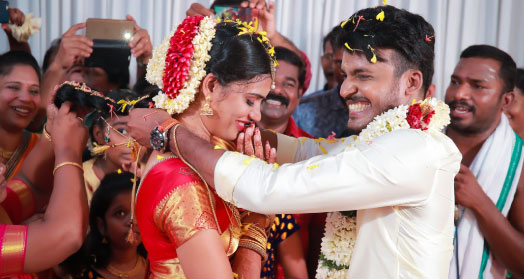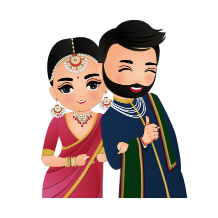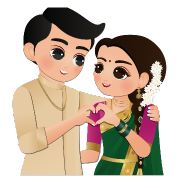Culture and Tradition

Are you ready to embark on an exhilarating
journey through the enchanting world of Telugu wedding rituals? It's time to
peel back the layers of tradition, uncover the hidden meanings, and demystify
the captivating customs that make these weddings truly unique. But hold on
tight, because we're about to take you on a rollercoaster ride of laughter,
intrigue, and awe!
Picture this: you're knee-deep in wedding
planning, trying to wrap your head around the intricate timeline of events,
while also grappling with the age-old question of what it all really means. Well,
Don’t worry, for we have cracked the code and are here to guide you through
this delightful labyrinth of traditions.
So, whether you're a curious soul, a cultural
connoisseur, or simply looking to add a touch of Telugu charm to your special
day, join us as we embark on this exhilarating adventure of decoding Telugu
wedding rituals. Get ready to laugh, learn, and fall head over heels in love
with the magic of tradition. Let the journey begin!
In the grand tapestry of Indian weddings,
Telugu wedding rituals form a vibrant and significant thread. Rich in
traditions and steeped in cultural customs, these rituals add a touch of magic
to the union of two souls.
From the auspicious Mangalashtakam to the
lively Saptapadi, each ceremony holds deep significance. The Telugu wedding
rituals encompass a range of beautiful traditions, such as the Muhurtham
(auspicious time), the sacred Kanyadaanam (giving away the bride), and the
joyous Talambralu (Pouring of rice mixture).
These rituals are not only a celebration of
love but also a way of honoring cultural heritage and bringing families
together. So, dive into the world of Telugu weddings and immerse yourself in
the enchanting beauty of these timeless rituals. Let the journey begin!
Before the big day, Telugu weddings come alive
with a flurry of captivating pre-wedding rituals. From the playful Pelli
Koduku/Kuthuru ceremony to the soul-stirring Ganesh Puja, these rituals set the
stage for the grand celebration ahead.
Discover the significance of Nischitartham, a
special pre-wedding ceremony in Telugu weddings. It marks the official
engagement, bringing both families together. They choose an auspicious date for
the wedding based on horoscopes. Gifts are exchanged, and the bride receives
beautiful clothes and gold from her future mother-in-law. Nischitartham sets
the stage for a joyful journey toward marriage, filled with blessings and
anticipation.
Pelli Koduku/ Kuthuru, a delightful pre-wedding
ritual takes place a day or two before the wedding, at the respective homes of
the groom and bride. This is similar to the Haldi ceremony but with a Telugu
twist. During this joyous event, a special paste called Naluga, made with
flour, turmeric, and aromatic oils, is lovingly prepared. The bride and groom
are then smeared with this fragrant mixture, followed by a purifying holy bath
using turmeric-infused water.
Mangala Snanam, means the Holy bath. On the
morning of the grand wedding, at an auspicious hour, the bride and groom
undergo ceremonial baths. Once refreshed, they slip into their clothing for the
special day, ready to embark on the rest of the enchanting rituals. Did you know
that this pre-wedding ritual bath in Telugu weddings, holds a fascinating
belief? It is believed that the holy waters possess the power to wash away any
negative energy and bless the couple with divine purity for their new journey
together. After Mangala Snanam, the family performs Aarti, praying for the
couple's happiness and wisdom to lead their lives.
Derived from the term "graduation,"
Snathakam marks the groom's transition to household responsibilities. Just a few
hours before the wedding muhurthaṃ, at the groom's abode, this remarkable
custom takes place. As part of the ritual, the groom adorns a symbolic silver
thread known as Yagnopavita or Janivaara, representing his newfound role.
In Telugu wedding rituals, Gauri Puja holds
immense significance. Before the wedding ceremony, the bride performs this
auspicious ritual at her house, accompanied by her family members. Gauri Puja
involves the worship of Goddess Gauri, seeking her blessings for a blissful
married life. During the ceremony, a significant custom called
"Pravara" takes place, where the bride's Gotram (clan) is changed
from her paternal Gotram to that of the groom. This signifies the bride's
transition into her new family and showcases the merging of two lineages.
Wedding Day
Rituals
The wedding day in Telugu weddings is a
whirlwind of rituals, traditions, and joyful celebrations that unite two souls
in matrimony.
Edurukolu &
Kashi Yatra
The Edurukolu ritual marks the arrival of the
groom and his family at the wedding venue, where they are warmly welcomed by the
bride's parents and family. On the wedding day, the groom's arrival is marked
by a playful and dramatic ritual called Kashi Yatra. The groom pretends to
embark on a journey to Kashi, symbolizing his intention to renounce marriage
and worldly pleasures. Carrying a walking stick and an umbrella, he is
intercepted by the bride's brother or cousin, who convinces him to embrace the
responsibilities of a Grihastha (householder). The groom then returns to the
wedding venue, ready to begin his new life. Kashi Yatra in old times was done
to attain knowledge and spirituality and this ritual showcases his readiness to
embrace the married life and contribute to the society while nurturing his
intellectual pursuits.
Ganesh Puja
The wedding kicks off with the groom doing the Ganesh
Pooja at the maṇḍapaṃ. This ritual is meant to keep away any negativity and
difficulties in their future life together. It's a way to seek blessings for a
joyful and successful union between the bride and groom.
Bride’s Entry and
Terasala
The bride is accompanied by her awesome
maternal uncle and aunt, making sure she arrives in style. They can go all out
with a fancy Pallaku or strut their stuff under a fabulously decorated canopy.
And wait, there's more! To build up the suspense, a magical curtain called
Terasala separates the bride and groom, keeping them on their toes until the
perfect moment.
Kanyadanam &
Panigrahanam
In the emotional ritual of Kanyadanam, the
girl's family humbly entrusts the responsibility of their beloved daughter to
the groom. As the groom is revered as Lord Vishnu and the bride as Devi
Lakshmi, the parents ceremoniously wash their feet, acknowledging his divine
presence. With Panigrahanam, the groom tenderly clasps the bride's hand,
affirming his unwavering commitment to be her eternal companion, embracing
righteousness, financial support, desires, and spiritual unity.
Jellakara Bellam
In the beautiful Telugu wedding tradition, the
couple takes part in a unique ceremony called "Jellakara-Bellam."
Following the recitation of sacred verses by the priest, they playfully apply a
special paste made from cumin seeds and jaggery on each other's heads. This
joyful act symbolizes the unbreakable bond and inseparability of the married
couple. As the auspicious muhurta arrives, the curtain separating them is
removed, officially marking them as husband and wife.
Mangalsutram
After the Jellakara Bellam ceremony, the bride
and groom slip into their elegant madhuparakam attire, adorned in white or cream-colored
garments with vibrant red, green, or yellow borders. Meanwhile, the pandit
reverently places the Mangalasutram, a sacred necklace, on a coconut, seeking
divine blessings. As the couple returns, the groom lovingly fastens the Mangalasutram
around the bride's neck. This yellow thread, embellished with two golden
pendants known as Sutralu, is tied with three knots representing their
thoughts, speech, and actions. The ritual signifies the profound union of the
couple, both in body and spirit.
H3: Talambralu
In the Talambralu ritual of a Telugu wedding,
things get a little messy, but in a good way! The bride and groom playfully
shower each other with rice mixed with turmeric, turning the ceremony into a
colorful, rice-filled extravaganza. As they exchange the rice, guests join in,
adding a sprinkle of blessings and turning the occasion into a vibrant
celebration of love and unity. The ritual ends with Dandalu (garlands)
exchange.
H3: Saptapadi Rituals
Saptapadi rituals mark the completion of the
marriage as per the Vedic scriptures. The bride and groom have a playful moment
where they tie together items like beetle nuts, turmeric twigs, dates, and
coins in a closed knot. The groom's sister helps secure the knot. Then, the
groom places a black bead necklace (Nalla Pusalu) around the bride's neck to
ward off negativity. They take seven steps (Saptapadi) around the fire,
exchanging vows and promising to be there for each other. It's a lovely way to
seal their lifelong commitment!
H3: SthaaliPaakam
& Pradhanam
In Telugu weddings, Sthaalipaakam and Pradhanam
rituals infuse joy and merriment. During Sthaalipaakam, the groom delicately
adorns the bride's feet with gleaming silver toe rings, symbolizing her
newfound married status. Excitement fills the air as the couple engages in
Pradhanam, a delightful game of fishing for a ring in a pot of water. The
victor is playfully hailed as the dominant force in their matrimonial journey,
while chants and enthusiastic cheers create an atmosphere of sheer celebration.
H3: Arundhati
Nakshatram
In a sacred moment beyond the Mandap, the
priest leads the couple to gaze upon the stars, representing the celestial bond
of Vashishtha Rishi and Arundhati. Honored as an exemplary couple in ancient
scriptures, their radiant presence serves as a guiding light for the newlyweds.
This enchanting ritual imparts wisdom and inspiration, setting the stage for a
harmonious and blessed journey ahead, as the couple embarks on their shared
path of marital bliss.
H2: Post-wedding
Rituals
The wedding celebration extends beyond the
ceremony, bringing families closer and rejoicing in the newfound union. It's a
time of pure joy, strengthening the bonds of love and creating lasting
memories.
H3: Grihapravesham
After the bride arrives at the groom's house,
the mother-in-law welcomes her with an Aarti. She then sprinkles some rice and
water at the entrance of the house and asks the bride to enter with her right
foot first. A Kalash filled with rice
is kept at the entrance, which the bride has to topple with her right foot
before entering.
H3: Sathyanarayan
Vratam
This sacred ceremony is performed by the
newlyweds along with their families to seek blessings from Lord Satya Narayan
for a happy and prosperous life ahead. It is considered a way of thanking God
for the successful completion of the wedding ceremony. This post-wedding
tradition is significant and a beautiful way to start a new journey together
H3: Reception
The Telugu post-wedding ritual of the reception
is a delightful extravaganza that showcases the couple's joyous union. With
captivating decor and a unique theme, the reception venue transforms into a
magical wonderland. Guests indulge in a culinary feast, savoring delectable
food that tantalizes their taste buds. The air is filled with laughter and
merriment as the bride and groom are showered with blessings and warm wishes,
creating beautiful memories that will be cherished forever.
H2: Conclusion
In the kaleidoscope of colors, customs, and
traditions that define Telugu weddings, we find the true essence of love,
unity, and cultural richness. At My Wedding Palette, we take pride in curating
unforgettable experiences that honor these cherished rituals. We hope this blog
has enlightened you about the beauty and significance of Telugu wedding
traditions. Your feedback is valuable to us as we strive to continually enhance
your wedding planning journey. Share your thoughts with us and let us create a
magical wedding experience for you.

Latest Articles

Destination

Wedding Favours & Gifts

Pre-Wedding Planning

Videographers & Photoshoot

Jewellery

Mehndi

More Blogs

 12
12


Follow Us
For More Inspiration On Instagram
Lorem ipsum dolor sit amet, consetetur sadipscing elitr, sed diam nonumy eirmod tempor invidunt ut labore et dolore magna aliquyam erat, sed diam voluptua. At vero